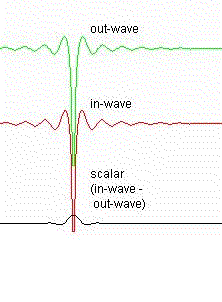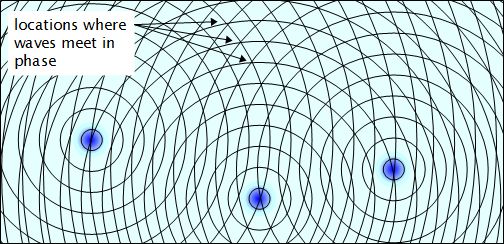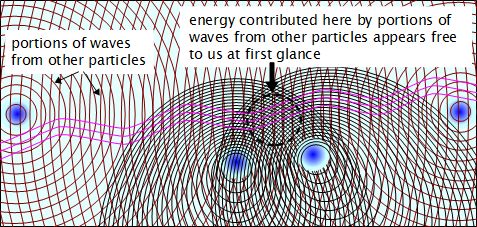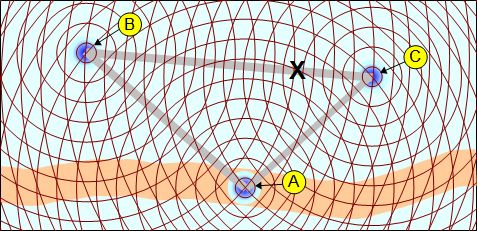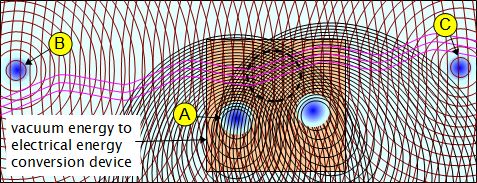Creating particles by manipulating waves
The Standard Model looks at the vacuum as being filled with random fluctuations, vacuum meaning simply the area between particles. Another way of looking at it that is perhaps more engineerable is as the vacuum being filled with waves, these waves moving from particle to particle. If you look at any one location in this vacuum, you'll see such a large collection of these waves moving in every direction that it'll look like random fluctuations.
Since the waves originate at particles, to set the location and direction of a wave, you need first only move the particle that the wave will originate from.
In keeping with this wave model, the particles themselves are composed of waves. It's also long been known from experiment that particles have spin and that this spin is ultimately the origin of magnetism.
So to create a new particle you may need only arrange the waves at a particular location in an appropriate manner and introduce some spin.
Non-linear space at particle center
|
The space at the center of a particle must be non-linear so that the waves there can spin. The space in between particles is linear and waves travelling through that space do not interfere with each other and instead simply continue in the direction in which they were already travelling. The degree of linearity of any location in space is determined by the density of space, or more precisely, the total of the square of the amplitude of all waves at that location. More specifically the energy density at any point in space is:
This means that the frequency, f, or mass, m, of a particle depends
on all N particles within the hubble sphere surrounding a particle
in inverse proportion to the square of the distance to those particles,
rn, and the square of the amplitudes of their waves,
At the center of a particle, such as an electron, the density is much higher than that of the surrounding space, and therefore it is non-linear and waves travelling in the center travel in a non-linear path. The non-linear path that waves take at the center of a particle is what accounts for the property of spin. The animation on the right is derived from actual electron wave equations. The green waves are the waves leaving the electron, the out-waves. The red waves are arriving at the electron, the in-waves. The bottom standing wave is a result of the two out- and in-waves, which for the electron is the amplitude of the in-wave minus the amplitude of the out-wave. The point of the animation is to show that the wave amplitude at the center of the particle is significantly higher than the amplitude of these waves in the surrounding space. |
|
Arranging waves to create non-linear locations of space
To create non-linear locations in space, it is necessary to arrange particles such that the waves originating from those particles all meet at discrete locations. These locations are conducive to particle creation provided the waves are either in phase or 180° out of phase at those locations. Being 180° out of phase is acceptable since it is the sum of the square of the amplitudes that is important.
|
Since all particles by there very nature are always trying to reach resonance with all other particles, should there be any of these areas then their locations would tend to be stable.
Note that at that location, the amplitudes of waves originating from near particles will be higher than the amplitudes of waves originating from distant particles and so will play a more significant part in particle creation.
Also, since the in- and out-waves travel through space, the density at that location will be oscillating.
Using doppler effect to increase number of waves per area.
The use of the doppler effect may be one possible appropriate way to arrange waves to increase the number of waves in an area and will be used as an example here. If a particle is moved unidirectionally then the waves in the direction of that movement will be closer to each other than they would be if the particle were not moving. At the same time, the waves eminating from the particle behind it will be further apart.
|
Using a magnetic field to provide initial spin.
As already stated, particles have the property of spin and this spin is the source of magnetic fields. This spin is a result of the in-wave arriving at the particle center, undergoing 720° of spherical rotation and then being emitted as an out-wave. Somehow this spherical rotation has to be kick-started within the nascent particle.
All that may be needed to supply the initial spherical rotation for particle creation is to supply a magnetic field. A magnetic field is just a formation of waves moving through the vacuum. The form those waves take originates with the spin of the particles that created those waves and whatever was going on with those particles during the emission of those waves (e.g. an electron moving through a conductor will emit waves that take the form of a magnetic field.)
The end result in the following diagram is an area conducive to particle creation according to the idea being put forth here.
|
Contribution of waves from other particles.
Any other waves passing through the particle creation area will also contribute to new particles. This is the case even if they were neither coming from nor headed to any of the particles in our apparatus. They could be a light-year away or down the street. However, the closer a particle is, the higher the amplitude of its waves would be at this point and therefore the greater the contribution.
|
Implications of interfering with waves.
Particles exchange energy by exchanging portions of waves. This is illustrated in the following diagram. Particle A has a bunch of circular waves eminating from it, as do particles B and C. When a portion of a wave from A arrives at B, along with portions of waves from other particles, B emits a new wave, a portion of which heads back to A. A and B exchange energy in this way, as do all other particles. The greyed areas highlight the portions of waves that are involved in energy exchanges between any two particles.
|
To interfere with the energy exchange between A and B you can interfere with the wave portions in the narrow grey area directly between the two particles. If A is a particle in a copper wire, interfering with those wave portions will interfere with the electrical circuit that the wire is a part of.
But now, what if you were to interfere with the waves at the location marked X? Obiviously that would interfere with the energy exchange between B and C. Less obvious is that if C is interfered with, that would also affect A since C is also doing an energy exchange with A. However, C is also doing an energy exchange with every other particle that its emitted waves reach. So the energy change that occurs at C will affect every particle that C's wave reaches out to and has to be spread out amongst all those particles. The closer a particle is, the larger the effect will be on that particle. So while an energy exchange is highlighted here between A and C, there are an enormous number of other particles not shown that are also doing energy exchanges with C. Particle A will feel only a subset of the effect that a change at X will have on C.
Also not so obvious is that A has a wave portion passing through location X and there is assuredly a particle in that direction that A is doing an energy exchange with. So while not obvious, A will be affected directly.
Back to particle creation...
Applying the above energy exchange issues to Figure 5 we now come up with the following diagram. The particles have been labelled to correspond to the labelling in the above energy exchange diagram.
|
Particle A is shown to be a part of a device which creates charged particles using energy from the device along with contributions of other particles in the Universe. Particles B and C are not a part of the device.
Three things contribute to particle creation. The first is the average space energy density at the location of the particle. This energy comes from waves from all particles in the universe. However, this average energy density alone is not enough to make space non-linear. To do that we position local particles such that the sum of the square of their wave amplitudes at the location will add sufficiently to the space density to make space non-linear. This is aided by the inverse radius squared component in the space density equation. The ampliudes of waves from local particles will be greater than those of distant particles and so will have a significant effect on the density and resulting non-linearity. The final contribution is the presence of a magnetic field to provide initial spin.
To be useful, the newly created particles must have either positive or negative charges but may be short or long lived. In the device they would contribute by increasing electrical current and electrical voltage. But contrary to what you might think, the new particles need not have momentum.
One common misconception amongst free energy researchers is that merely collecting stray electrons will give you energy. What is forgotten or unknown is that it takes energy to gather those electrons. Wherever they are gathered to there will be a charge imbalance and so work will result by the restoration of balance. However, the energy in that work came from the energy used to collect the electrons in the first place.
This process under consideration here is not analogous. The reason is that only a part of the energy of creating the charged particles was supplied by the device. The remainder was supplied by waves from other particles that are not a part of the device. They of course lost energy and so conservation of energy is maintained. The reason momentum is not needed and yet electrical current arrises is that the presence of the new charged particles introduces a charge imbalance and so work results by the restoration of balance. Once the circuit is neutral again, more particles can be created and so on.
As a side note, one helpful way out for the above free energy researcher collecting stray electrons is if the collected electrons had usable momentum prior to their capture.


 n, at the particle
location. The hubble sphere is a sphere of radius R=c/H, where H is
the hubble constant.
n, at the particle
location. The hubble sphere is a sphere of radius R=c/H, where H is
the hubble constant.
